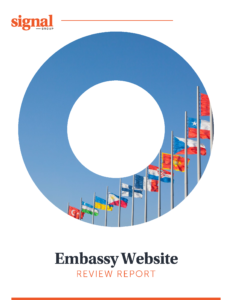The role of digital diplomacy has transformed foreign policy as ambassadors to Presidents and Prime Ministers harness the power of engaging foreign and diaspora audiences directly. Digital media has offered a low-cost way to engage, persuade and influence the citizens of allies and adversaries alike to understand, if not adopt the interests of the sponsoring country.
To date, social media has dominated public diplomacy strategies, which makes sense, as Twitter, Facebook, Clubhouse, TikTok and others directly engages audiences in innovative and creative ways to influence and sway its targets. However, this focus on social media has shifted attention away from one of the workhorses of digital diplomacy: the embassy web site.
Download the Embassy Website Report
An embassy’s website is an expression of a country’s brand and of how it wants to be perceived in the world. It is also the front door where users find information about a country, its policies towards the U.S. and services for visitors and its citizens.
As former diplomats and digital diplomacy officials, we know the power of agile, creative digital communications to shape the ground for policymaking. We practiced these skills in our careers in the U.K. and U.S. governments. Now, at Signal Group, a public affairs consultancy, we wanted to assess the state of digital diplomacy through the lens of embassy websites here in the U.S.
We studied over thirty countries’ embassy websites to evaluate how sophisticated and successful they were in representing their country. Our goal is to help ambassadors and digital diplomacy officials to evaluate their websites, consider best practices and look for ways to better serve their constituents and represent their country.
Our review shows that while a few embassies had excellent examples, on average we found that embassies are sorely neglecting their “front door” for their country. Embassy sites we reviewed needed significant updates in design, usability content, and structure. A few were even deeply concerning with their lack of security or ability to be utilized on a mobile device.
However, as above, there were a number of embassies that were best in class for the whole site, or at least key features. We found that Sweden and the United Arab Emirates hit full marks in design and brand that represented the country and its relationship with the U.S. well. These sites had a modern sensibility and design, they reflected a thoughtful user experience. They were clear in how the embassy wanted to speak to important topics of politics and policy, trade and investment, tourism, and consular information.
Embassy websites can be a bewildering tangle of information, forms and content, so a strong home page, site navigation and well-formatted content pages are incredibly important. We admired Panama’s home page for its clarity and hierarchy. New Zealand and Portugal were our picks for the best navigation should be considered as good examples of putting best practices into use. Saudi Arabia and France exhibited the best content page design that allowed information to stand-out with good layout and spacing.
Beyond design embassy sites must stand-out with high quality presented in an understandable way. We looked at pages dedicated to the Ambassador, consular affairs, trade, and investment and finally, tourism and culture. The Ambassador’s page is designed to showcase the ambassador to the U.S. and enhance their standing as an experienced, trusted, and influential representative of their country. The Embassy of Ecuador had a strong example that allowed us to understand the Ambassador’s career, duties, and accomplishments, as well as learn a bit more about them and their perspective on their assignment. The consular affairs pages of Tunisia were outstanding, as were the trade and investment offerings of Mali, Ghana and Norway. We also loved the tourism and culture sites of Australia, France, and Croatia.
While we found bright spots, even in the sites above we also found a significant number of problems. In our review of the thirty-eight embassy websites, we found significant and easily avoidable issues, such as broken links and pages, sorely out-of-date designs, broken navigation, flat and unreadable content, and poorly executed imagery. The most common problems:
Our review of the embassy websites in the U.S. was a perspective on how a country represents itself to official Washington, the U.S. public, and its own citizens abroad. The website, along with the speech, the event, and the social media account, are all extensions of foreign policy, a country’s brand, and how it presents itself to the world. While there were a few wonderful examples, our review suggests that Embassies and foreign ministries should spend additional time thinking about updating and improving their websites.
Download the Embassy Website Report

For more information, please contact:
Robert Bole is a Managing Director and Chair of Signal’s digital practice. A former digital media executive he was also the Director of Innovation and Global Strategy at the U.S. Agency for Global Media, and spent time at the State Department as an advisor to the Undersecretary of Public Diplomacy and Public Affairs.